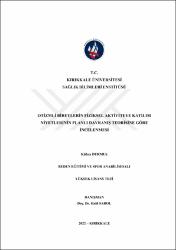| dc.contributor.advisor | HALİL SAROL | |
| dc.contributor.author | KÜBRA DURMUŞ | |
| dc.date.accessioned | 2022-10-12T07:35:14Z | |
| dc.date.available | 2022-10-12T07:35:14Z | |
| dc.date.issued | 13.01.2022 | en_US |
| dc.date.submitted | 2022-01-13 | |
| dc.identifier.citation | Otizmli bireylerin fiziksel aktiviteye katılım niyetlerinin planlı davranış teorisine göre incelenmesi / Examination of intentions to participate in physical activity of individuals with autism according to planned behavior theory
Yazar:KÜBRA DURMUŞ
Danışman: DOÇ. DR. HALİL SAROL
Yer Bilgisi: Kırıkkale Üniversitesi / Sağlık Bilimleri Enstitüsü / Beden Eğitimi ve Spor Bilimleri Ana Bilim Dalı
Konu:Spor = Sports
Dizin: | en_US |
| dc.identifier.uri | https://hdl.handle.net/20.500.12587/18137 | |
| dc.description.abstract | Bu araştırmanın amacı, otizmli bireylerin fiziksel aktiviteye katılma niyetlerinin planlı davranış teorisine göre incelenmesidir. Araştırmaya, otizmli çocuğa sahip 16 ebeveyn (9 anne, 7 baba) gönüllü olarak katılım sağlamıştır. Araştırmanın teorik çerçevesini, planlı davranış teorisi oluşturmaktadır. Araştırmada çalışma grubu, ölçüt örnekleme yöntemi ile seçilmiştir. Veriler, demografik bilgi formu ve yarı yapılandırılmış görüşme formu hazırlanarak toplanmıştır. Hazırlanan demografik bilgi ve yarı yapılandırılmış görüşme formu kapsamında; katılımcılar ile yüz yüze görüşme ve çevrim içi uygulamalar aracılığıyla görüşmeler yapılmıştır. Toplanan veriler, tematik analiz yöntemiyle analiz edilmiştir. Tematik analiz yöntemi kapsamında; davranışsal inanç boyutunu toplamda 4 tema ve 10 alt tema, normatif inanç boyutunda toplamda 4 tema ve 9 alt tema ve kontrol inanç boyutunda ise toplamda 3 tema ve 10 alt tema ortaya çıkmıştır. Araştırma bulgularına göre, davranışsal inanç boyutunda, katılımcıların fiziksel aktiviteye katılma niyetlerinde, 'hayatımızın önemli bir parçası' teması kapsamında, avantaj olarak OSB'li bireyler için fiziksel aktivitenin, daha çok motor gelişime katkı sağladığı, normatif inanç boyutunda ise, 'bizi yönlendirdiler' teması kapsamında, OSB'li bireylerin genellikle özel eğitim öğretmeni ve doktor gibi uzman kişiler tarafından teşvik edildikleri tespit edilmiştir. Son olarak kontrol inanç boyutunda ise, hem 'kendimiz çözüm üretiyoruz' hem de 'çok fazla engelle karşılaşıyoruz' teması dahilinde, ulaşım ve maddi imkanların fiziksel aktiviteye katılımda hem kolaylaştırıcı hem de zorlaştırıcı olduğu tespit edilmiştir. Sonuç olarak, davranışsal inanç boyutunda OSB'li bireylerin fiziksel aktiviteye katılımında, genel anlamda olumlu bir tutum gösterdiği, normatif inanç boyutunda, fiziksel aktiviteye katılma niyetlerinde, olumlu geri dönüşlerinin olduğu ve kontrol inanç boyutunda ise, zorlaştırıcı faktörlerin ortadan kaldırılmasının katılımı önemli ölçüde arttırdığı söylenebilir. | en_US |
| dc.description.abstract | The aim of this research is to examine the intentions of individuals with autism to participate in physical activity according to the theory of planned behavior. 16 parents (9 mothers, 7 fathers) of children with autism voluntarily participated in the study. The theoretical framework of the research is the theory of planned behavior. In the study, the study group was selected by criterion sampling method. Data were collected by preparing a demographic information form and a semi-structured interview form. Within the scope of the prepared demographic information and semi-structured interview form; Interviews were conducted with the participants through face-to-face interviews and online applications. The collected data were analyzed by thematic analysis method. Within the scope of thematic analysis method; 4 themes and 10 sub-themes emerged in the behavioral belief dimension, 4 themes and 9 sub-themes in total in the normative belief dimension, and 3 themes and 10 sub-themes in total in the control belief dimension. According to the research findings, in the behavioral belief dimension, the participants' intention to participate in physical activity, within the scope of the theme 'an important part of our lives', as an advantage for individuals with ASD, physical activity contributes more to motor development, and in the normative belief dimension, 'they guided us'. In this context, it has been determined that individuals with ASD are generally encouraged by specialists such as special education teachers and doctors. Finally, in the control belief dimension, it has been determined that transportation and financial opportunities are both facilitating and complicating participation in physical activity, both under the theme of "we produce solutions ourselves" and "we encounter too many obstacles". As a result, it is concluded that in the behavioral belief dimension, individuals with ASD have a generally positive attitude in their participation in physical activity, in the normative belief dimension, their intention to participate in physical activity, they have positive feedback, and in the control belief dimension, removing the complicating factors will significantly increase participation. | en_US |
| dc.language.iso | tur | en_US |
| dc.publisher | Sağlık Bilimleri Enstitüsü / Beden Eğitimi ve Spor Ana Bilim Dalı | en_US |
| dc.rights | info:eu-repo/semantics/openAccess | en_US |
| dc.subject | Spor = Sports | en_US |
| dc.title | Otizmli bireylerin fiziksel aktiviteye katılım niyetlerinin planlı davranış teorisine göre incelenmesi | en_US |
| dc.title.alternative | Examination of intentions to participate in physical activity of individuals with autism according to planned behavior theory | en_US |
| dc.type | masterThesis | en_US |
| dc.contributor.department | Kırıkkale Üniversitesi, Spor Bilimleri Fakültesi, Beden Eğitimi ve Spor Bölümü | en_US |
| dc.relation.publicationcategory | Tez | en_US |
















